A Simple Guide to the Hario V60 Carafe
The Hario V60 is a popular coffee maker you can find in fancy cafes and home kitchens. It's the cone-shaped dripper that sits on top of a glass server. It's known for making a very clear and tasty cup of coffee.
But getting started with the V60 can feel complicated. There are different sizes and materials, and it takes practice to get it right. This guide will break everything down for you.
What is the Hario V60 Carafe?
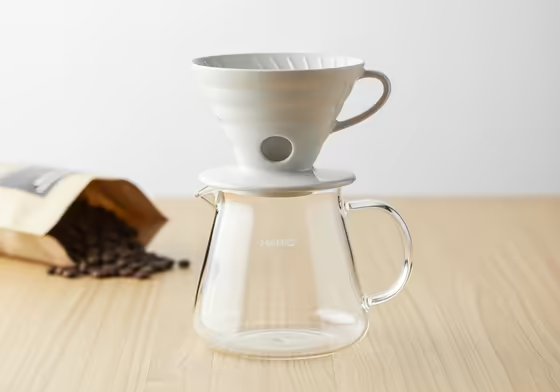
Dripper vs. Carafe
First, let's clear something up. The name "Hario V60" actually refers to the cone-shaped funnel, which is called the dripper . This is the part that holds the filter and coffee grounds.
The Hario V60 Carafe is the glass pot that sits under the dripper. It's also called the V60 Range Server. It's made from a special, heat-proof glass and has a classic beehive shape.
This guide is about the carafe, but it's designed to work perfectly with the V60 dripper. They're a matching set.
Why is it called V60?
The name "V60" describes the dripper, not the carafe. It's a pretty simple name.
- V stands for the V-shape of the cone.
- 60 stands for the 60-degree angle of the cone.
That 60-degree angle is what makes the V60 special. The steep angle helps water flow through the coffee grounds more evenly. This design, along with ridges inside the cone, gives you a lot of control over how your coffee tastes.
Do you need a carafe for the V60?
No, you don't have to use a carafe. The V60 dripper is designed to sit right on top of most coffee mugs.
Sometimes, a dripper can create a seal on a mug and stop the coffee from flowing out. The V60 has little ridges inside that let air escape, so this doesn't happen. Brewing into your mug is easy and works just fine for a single cup.
Do you need a carafe for pour over coffee?
Nope. "Pour-over" just means pouring hot water over coffee grounds. You can let the coffee drip into whatever you want, including the mug you're going to drink from.
So what is the point of a carafe?
If you don't need a carafe, why do so many people use one? It's not about need , it's about making the experience better. Here are five good reasons to use one.
- Making More Coffee: This is the main reason. A standard carafe holds enough coffee for two large cups. This makes it great for sharing.
- Better Taste: When you brew coffee, the first drops are strong and the last drops are weak. Swirling the coffee in the carafe mixes it all together so every cup tastes the same. The swirl also releases more of the coffee's aroma.
- Controlling Temperature: A big mug of coffee cools down slowly, and the last sips can be lukewarm. A carafe keeps the whole batch hot. You can pour a small amount into your cup, which cools quickly to the perfect drinking temperature.
- Easier and Safer: A carafe has a wide, stable base that's safer than balancing a dripper on a tall mug. It's also the only safe way to make Japanese-style iced coffee. Brewing hot coffee directly over ice can shatter a normal ceramic mug.
- It's a Nice Ritual: For a lot of people, using the beautiful glass server is part of a relaxing morning routine. It just makes the whole process more enjoyable.
Buying Guide and Reviews
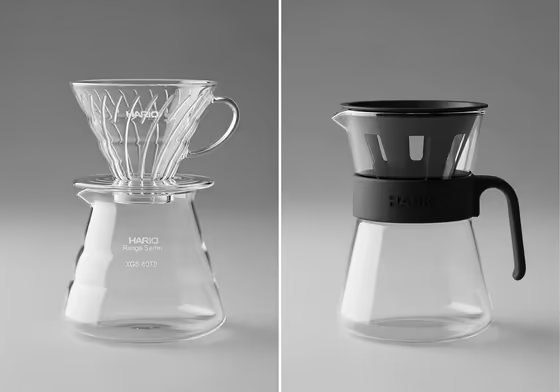
Hario V60 Range Server Review
This is the classic, beehive-shaped glass server that you usually see with a V60 dripper.
- Pros: The design looks great and works well. It's made from strong but lightweight glass that won't add any flavor to your coffee. It's also safe for the microwave and dishwasher. The lid keeps heat in and can be flipped over to hold your dripper after you're done brewing.
- Cons: The lid isn't a tight seal, so it won't keep your coffee hot for a long time. And even though it's durable for home use, it's still glass and can break.
- Sizes: It comes in three sizes: 01 (360 ml), 02 (600 ml), and 03 (800 ml).
Hario V60 Drip Decanter Review
This is an all-in-one brewer that combines the dripper and carafe into one piece. It's a lot like a Chemex.
- Pros: This is a great, low-cost option if you're just starting out. It comes with everything you need, including paper filters. The glass decanter has a silicone band so you can handle it when it's hot.
- Cons: The dripper cone that comes with it is made of plastic. Some people prefer brewing with only glass or ceramic. Also, you have to lift the wet dripper out before you can pour a cup, which can be a little awkward.
Range Server vs. Drip Decanter: Which to Buy?
Your choice really comes down to one thing. Do you want separate pieces or an all-in-one brewer?
- Choose the Drip Decanter if: You're a beginner and want the cheapest, easiest way to start. You like the all-in-one look and don't mind that the dripper part is plastic.
- Choose the Range Server if: You want to build your own custom setup. The Range Server is just a pot, so you have to buy a dripper separately. This lets you pick any dripper you want, whether it's ceramic, metal, or glass.
What People on Reddit Say
On Reddit, people often say the Drip Decanter is a great, affordable alternative to a Chemex. There's a big debate about whether plastic or ceramic drippers are better. Some say ceramic holds heat better, while others argue that plastic is more consistent because it doesn't pull heat away from the coffee.
In the end, most people agree that a carafe is a nice accessory, but you don't absolutely need one. Many coffee lovers own a server but still brew straight into a mug on most days. They save the carafe for when they're making coffee for two or just want to enjoy the ritual.
Hario V60 Carafe Price
You can get started with the V60 system for a low price and add more parts later. Here's a general idea of costs.
- Entry-Level (V60 Coffee Server): This model has a glass pot with a plastic handle. It's the cheapest option, usually around $15.50.
- Mid-Range (V60 "Clear" Range Server): This is the classic all-glass beehive server. It usually costs between $25.95 and $28.00 for the standard 600 ml size.
- All-in-One (V60 Drip Decanter): This whole kit, with a dripper and filters, is a great deal at around $30.50.
- Premium (V60 Insulated Server): Hario also makes a thermal server that keeps coffee hot for much longer. It costs a lot more, around $54.50.
Where to Buy a Hario V60 Carafe
You can find Hario products in a lot of places.
- Direct: The official Hario-USA.com website has the biggest selection.
- Big Retailers: Amazon sells a lot of Hario gear and often has good prices, especially on the Drip Decanter.
- Specialty Coffee Shops: Online coffee stores are a great place to look. They almost always stock the most popular models, like the 02 Range Server.
Is the V60 System a Good Investment?
Yes, the Hario V60 system is worth it if you want to make a really clean and flavorful cup of coffee.
But here's the thing about the "investment." A plastic V60 dripper is very cheap, often less than $10. The real cost is the other gear you need to make it work well.
If you use a V60 with pre-ground coffee and a regular kettle, you'll probably be disappointed. To get great results, you really need to invest in three other things.
- A good burr grinder
- A gooseneck kettle
- A digital scale
The V60 is a cheap tool that needs expensive friends. For people who are really into coffee, this investment is a clear "yes."
Choosing Your Hario V60 Carafe
Size and Type
What's the difference between Hario V60-01 and 02?
The numbers 01, 02, and 03 just refer to the size. They tell you how much coffee the dripper and matching carafe can make.
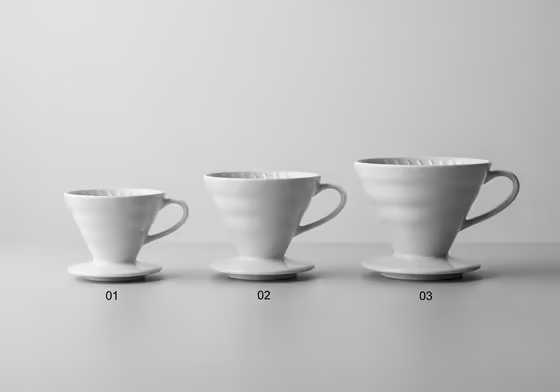
- Size 01: This is for 1–2 cups. It's best for brewing a single serving.
- Size 02: This is for 1–4 cups. It's the most common and versatile size.
- Size 03: This is for 1–6 cups. It's used for making large batches.
The 01 and 02 drippers have the same 60-degree angle. The 02 is just taller and has a wider opening. This size difference actually changes how you brew.
A lot of people buy the 02 thinking it can do everything. But if you try to make a small, single cup in an 02 dripper, the coffee grounds form a shallow layer. Water flows through it too fast, and you end up with a sour, weak coffee.
So, here's the takeaway. If you know you'll only be making coffee for yourself, the Size 01 is the better tool for the job. If you think you'll ever want to make coffee for two, the Size 02 is the smarter choice.
Is a glass or thermal carafe better?
This choice is a trade-off. Do you care more about the experience of tasting the coffee or the convenience of keeping it hot for a long time?
-
Glass Carafes
are for people who like to taste their coffee as it cools.
- Pros: They're cheap, light, and you can put them in the microwave. The glass is clear so you can see your coffee brewing. As the coffee cools, you can notice different flavors coming out.
- Cons: They don't keep coffee hot for very long and they can break.
-
Thermal Carafes
are for people who want to drink hot coffee over a longer period.
- Pros: They keep coffee hot for hours and are made of durable stainless steel.
- Cons: They cost a lot more. They're also heavy, you can't see inside them, and they can be hard to clean. Some people say they can hold on to old coffee smells.
The choice is pretty clear. If you brew coffee and drink it right away, the glass carafe is a better experience. If you make a big pot and want it to stay hot for an hour or more, the thermal carafe is the right tool.
| Feature | Hario Glass Carafe | Hario Thermal Server |
|---|---|---|
| Heat Retention | Poor. Designed for immediate serving. | Excellent. Keeps coffee hot for hours. |
| Durability | Low. Made of glass; can shatter. | High. Made of stainless steel. |
| Taste Impact | None. Glass is inert. Allows "staged cooling" to reveal flavors. | Neutral, but can retain odors if not cleaned. |
| Aesthetics/Process | Classic, "beehive". Transparent; can see brew. | Utilitarian, sleek.[67] Opaque. |
| Cleaning | Easy. Dishwasher & microwave safe.[2, 40] | Difficult. Requires disassembly.[62, 68] Prone to staining.[65] |
| Price | Affordable.[27, 40] | Premium. |
Skill Level
Is the Hario V60 good for beginners?
This is a common question, and the honest answer is no, not really.
The Hario V60 is not a forgiving coffee brewer. It has a steep learning curve and is harder to use than other brewers like the Kalita Wave or Chemex.
The reason is its design. The cone shape and large hole give you total control over the brewing. For an expert, this is a great feature, but for a beginner, it can cause problems.
The V60 is very sensitive to small mistakes. If your coffee grind is a little too coarse or your pour is a bit uneven, you'll taste it. The coffee will likely turn out sour and weak.
The V60 is only good for beginners who are ready to buy the whole kit. You can't get good, consistent coffee from a V60 without a digital scale and a gooseneck kettle. For an easier start with less gear, a different brewer might be a better choice.
How to Use Your Hario V60 Carafe
Equipment and Setup
What do you need for a V60?
A complete V60 setup includes a few key pieces of gear.

- Hario V60 Dripper: The cone itself, in the size and material you prefer.
- Hario V60 Paper Filters: You have to use the special filters made for the V60 cone.
- Vessel: A Hario V60 Carafe or just a sturdy coffee mug.
- Burr Grinder: This is the most important piece of equipment. A blade grinder makes uneven coffee grounds, which will ruin your V60 brew.
- Digital Scale (with Timer): Pour-over coffee is all about ratios, so a scale is a must-have for measuring your coffee and water.
- Gooseneck Kettle: This is considered essential for getting a good pour with a V60.
- Fresh Coffee Beans: Using freshly roasted, whole bean coffee makes a huge difference.
Do I need a gooseneck kettle for the V60?
Yes. While you can pour water from any kettle, experts agree that a gooseneck kettle is almost a necessity for the V60.
The V60 lets water flow through quickly. This means that you control how long the coffee brews, not the dripper. Your pouring technique is the most important factor.
A regular kettle dumps water out in a heavy, messy stream, making it impossible to be precise. A gooseneck kettle has a long, thin spout that gives you slow, steady control. This lets you pour in the gentle circles you need for a balanced cup of coffee.
Do you need to preheat the V60 and Carafe?
Yes. This is a required step for almost every V60 recipe.
- How to do it: Put a paper filter in the dripper and place it on your carafe. Pour hot water over the filter to wet it completely and warm up the carafe. Make sure you dump this water out before you start brewing.
This one step does two very important things.
- It Rinses the Filter: This washes away any paper taste from the filter, which gives you cleaner-tasting coffee.
- It Preheats Everything: This is the main reason. A cold dripper or carafe will instantly cool down your hot water. This will lead to a sour, weak cup of coffee. Preheating is key to keeping your brew at the right temperature.
Brewing Technique
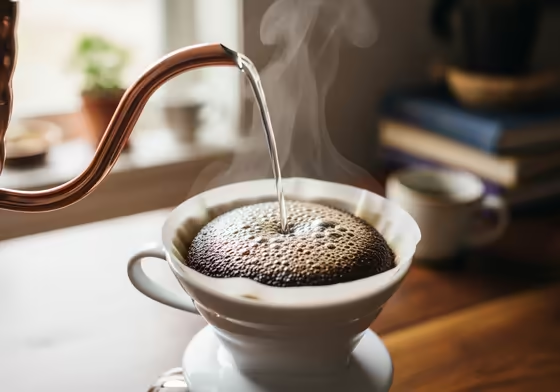
What is the golden ratio for the V60?
There's no single perfect ratio, but a great place to start is between 1:15 and 1:18 . This means you use 1 gram of coffee for every 15 to 18 grams of water.
- A 1:15 ratio (like 20g coffee to 300g water) makes a stronger cup.
- A 1:18 ratio (like 15g coffee to 270g water) makes a lighter, more tea-like cup.
- A 1:16 ratio is a popular starting point that works well for most coffees.
Don't be afraid to experiment to find what you like best.
What is the golden ratio for pour-over coffee?
The official "Golden Cup Standard" from the Specialty Coffee Association is 1:18. This is about 55 grams of coffee for 1 liter of water.
But that's just a general guideline. For pour-over coffee, most coffee experts suggest a slightly stronger ratio, somewhere between 1:14 and 1:16. A 1:16 ratio is a great place to start when you're trying a new coffee bean.
Is 212°F too hot for pour-over?
This is a common coffee myth. The simple answer is no, it's not too hot.
- The Textbook Answer: You'll often hear that the best water temperature is between 195°F and 205°F. People say that boiling water (212°F) will "scald" the coffee and make it taste bitter.
- The Practical Answer: Many of the world's best coffee brewers, including James Hoffmann, recommend using water right after it boils.
Here's the thing. The 195°F–205°F range is the ideal temperature of the coffee and water mixture in your dripper, not the water in your kettle.
Water loses a lot of heat as soon as you start pouring it. Starting with boiling water is a trick to make sure the actual brewing temperature gets hot enough. This is especially important for light roast coffees, which need more heat to extract all their flavor.
So, go ahead and use water just off the boil. The only time you might want to use cooler water is for very dark roasts, which can become bitter more easily.
Should you stir or swirl the V60?
You should do both. Stirring and swirling helps make sure all the coffee grounds get wet evenly. This prevents "channeling," which is when water finds a little path to sneak through the grounds without brewing them properly.
A popular technique from James Hoffmann gives a clear guide.
- During the Bloom: After your first pour, give the dripper a good swirl. This makes sure all the coffee grounds are wet, with no dry clumps.
- After the Final Pour: Once all the water is in, use a small spoon to stir gently. Stir once in each direction to knock any grounds off the side of the filter.
- The Final Swirl: After stirring, give the dripper one last gentle swirl. This flattens the bed of coffee grounds, which helps the water drain evenly and gives you a better tasting cup.
Care and Maintenance
Can you put a V60 in the dishwasher?
Yes. Hario's glass servers are made to be dishwasher safe. The plastic and glass V60 drippers are also safe to put in the dishwasher.
Is the Hario V60 carafe microwave safe?
Yes. Both the all-glass server and the models with plastic handles are made from heat-proof glass. You can safely put them in the microwave to reheat your coffee.
Hario V60 carafe replacement parts
The glass lid for the beehive-shaped server is the part that breaks most often. Hario does sell official replacement lids.
But here's something to watch out for. After you add shipping costs, a single replacement lid can cost as much as a brand new server. It often makes more sense to just buy a new one.
Common Issues: Cracking and Staining
-
Cracking:
The glass is strong, but it's not unbreakable. Some people have reported that the Drip Decanter cracks when making Japanese iced coffee. This is because pouring very hot coffee over a lot of ice creates a sudden temperature change that can shock the glass.
Warning: Avoid pouring hot coffee directly onto a large amount of ice in a glass carafe. The rapid temperature change (thermal shock) can cause the glass to crack or shatter. Brew separately and combine carefully.
- Solution: Be careful. It's safer to brew the hot coffee into the carafe first, then pour it over ice in a separate, stronger glass.
-
Staining:
The stainless steel thermal servers can get stained with coffee oils over time, which can affect the taste.
- Solution: Soap and water might not be enough. To deep clean it, you can use a special coffee equipment cleaner. A good trick is to dissolve a denture cleaning tablet in boiling water inside the server and let it soak.
V60 Carafe vs. Other Brewers
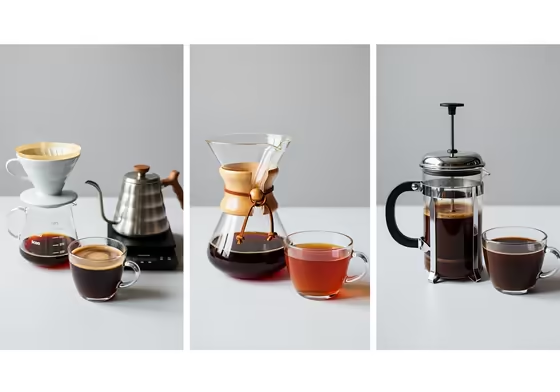
Is the V60 better than a Chemex?
This is a classic coffee debate. Neither one is "better," they just make different styles of coffee. The biggest difference is the paper filter.
- The Filter: Chemex filters are much thicker than V60 filters.
- How Chemex Tastes: The thick filter absorbs almost all of the coffee oils. This makes an extremely "clean" and "mild" cup of coffee with a light body.
- How V60 Tastes: The thinner V60 filter lets more natural oils into the cup. This results in a coffee with more body, a richer feel, and more complex, bright flavors.
- How to Brew: The V60 is tricky and takes practice. The Chemex is more forgiving because the thick filter controls the water flow for you, so your pouring technique matters less.
The takeaway is simple. Choose Chemex if you want a super clean, sweet cup that's easy to brew. Choose V60 if you want to taste all the bright and complex flavors a coffee has to offer.
Is the V60 better than a French Press?
This comparison is about two totally different ways of brewing coffee. They are designed to make opposite styles of coffee.
- The Method: A French press soaks the coffee grounds directly in water. A metal filter then pushes the grounds down, but lets all the oils and fine coffee particles into your cup. A V60 lets water pass through the coffee, and a paper filter removes all of those oils and particles.
- How French Press Tastes: This method makes a heavy, full-bodied, and rich cup of coffee. It's often described as "silty" because of the fine grounds left in the cup.
- How V60 Tastes: This method makes a "clean" and "bright" cup that is more like tea. The paper filter lets you taste the subtle, delicate flavors that a French press can hide.
- How to Brew: A French press is very easy to use, but it's messy to clean. A V60 is hard to master, but cleanup is super easy since you just throw the filter away.
So, choose a French press if you want a simple, bold, and heavy cup of coffee. Choose a V60 if you want a clean cup that lets you taste all the coffee's subtle flavors.
Brewer Comparison at a Glance
| Feature | Hario V60 | Chemex | Cafetière (French Press) |
|---|---|---|---|
| Brew Method | Percolation (Pour-Over) [118] | Percolation (Pour-Over) [109] | Full Immersion [117, 125] |
| Filter Type | Thin Paper [3, 115] | Thick Paper [3, 110, 111] | Metal Mesh |
| Taste Profile | Clarity & Complexity. Bright, acidic, nuanced, "tea-like". | Cleanliness & Sweetness. Soft, mild, sweet, very clean.[111, 113] | Richness & Intensity. Bold, heavy, rich, "silty".[116, 119] |
| Body (Mouthfeel) | Light-to-Medium [115, 116] | Light [3, 109, 112] | Very Heavy / Oily |
| Learning Curve | High. Very "fussy" and sensitive to technique. | Medium. More forgiving than V60 due to the filter.[112, 114, 115] | Low. Very simple and consistent.[116, 123] |
| Cleanup | Very Easy. Toss the paper filter, rinse the carafe.[121, 122] | Easy. Toss the large filter, rinse the carafe.[114] | Difficult. Messy, requires scooping grounds and disassembling the plunger.[121, 122] |